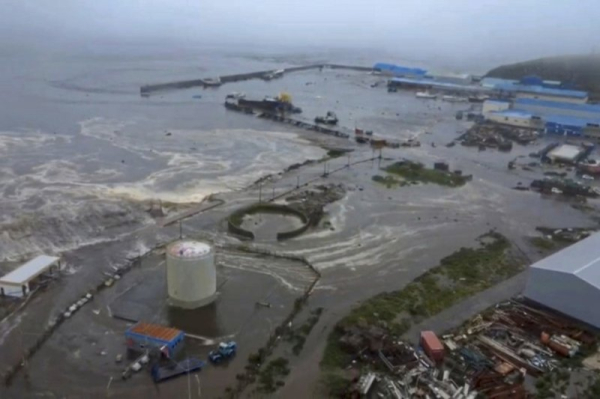

A still image taken Wednesday shows a flooded area in Russia’s Severo-Kurilsk, Sakhalin Region. Authorities in Russia’s Sakhalin region declared a state of emergency, after the 8.8 magnitude earthquake struck off Russia’s Kamchatka Peninsula, triggering global tsunami warnings and evacuation orders. Photo By EPA/Geophysical Survey of the Russian Academy of Sciences
Several warnings were downgraded on Wednesday in various areas that faced the threat of tsunamis after a magnitude 8.8 earthquake that struck near Russia late Tuesday.
Tsunami warnings were downgraded to advisories in Japan except for northern Hokkaido island and the northern Tohoku region of Honshu main island on the Pacific Coast, said Japan’s meteorological agency.
Warnings were downgraded as well in New Zealand, Australia and the Philippines.
Mexican officials said its tsunami alert was issued as a precaution.
“In reality the alert was issued but it did not generate major risks,” President Claudia Sheinbaum said Wednesday, adding that “there is no damage in Mexico.”
The U.S. Geological Survey said the 8.8 magnitude tsunami-stirring earthquake was one of the world’s most powerful since 1900. It came in sixth after Chile’s 9.5 mag earthquake in 1960 near Bio-Bio.
The highest waves so far to reach Japan were over 4 feet in Kuji in Iwatate prefecture to Japan’s north, according the Japanese meteorological agency.
Officials said tsunami activity was expected to continue in the morning with rapid tidal movements that may create dangerous conditions.
Tsunami warnings are live in Chile, Columbia and Easter Island.
However, the French Polynesian Marquesas Islands of Ua Huka, Nuku Hiva and Hiva Oa were expecting tsunami waves up to 13 feet high as authorities warned the local population to move to higher ground and heed pubic instructions.
“Our armed forces in French Polynesia are on alert as a precautionary measure, to be ready to assist our fellow citizens and state services in potential search and rescue operations or medical evacuations,” France’s Defense Minister Sebastien Lecornu said on X early Wednesday morning.
Kahului and the island of Maui in the Hawaiian island chain saw waves hit more than 5 feet high in some spots, and waves rose as high as 1 foot in Honolulu.
But Hawaii is “past the worst part” of its statewide tsunami warning, according to Chip McCreery, director of the Pacific Tsunami Warning Center. The state lowered to an advisory and, McCreery added, Hawaii is unlikely to “see any impacts bigger than we’ve already seen.”
Advisories, however, remained in effect for parts of the west coast, Hawaii and Alaska.
Meanwhile, the Los Angeles region in southern California is no longer under a tsunami advisory, according to NOAA.
Waves up to 3.6 feet were reported in Crescent City, Calif. and around 3-foot waves in Arena Cove.
“It was a long night for all of us,” Eric Weir, the city manager of Crescent City, told CNN.
“We were fortunate this time,” he added. “There was significant tsunami surges. We’re still dealing with those now, but it did stay within the banks of Elk Creek.”
Advisories were canceled for some coast parts of California from the Mexico border to Rincon Point some 15 miles southeast of Santa Barbara.
But they remained active from Rincon to the San Francisco Bay Area and in Oregon’s southern coastal region bordering California.
Experts say it was the strongest earthquake globally since 2011 and among the world’d top ten strongest ever detected.
It’s force caused Eurasia’s highest active volcano to erupt on the highest mountain of western Russia’s vast Siberia territory.
The Klyuchevskoy volcano burst to a powerful glow and lava explosion going down the western slope, the Kamchatka Branch of Geophysical Survey posted on Telegram.